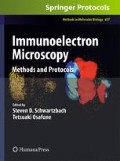Abstract
Cryofixation and freeze-substitution techniques preserve plant ultrastructure much better than conventional chemical fixation techniques. The advantage of cryofixation is not only in structural preservation, as seen in the smooth plasma membrane, but also in the speed in arresting cell activity. Immunoelectron microscopy reveals the subcellular localization of molecules within cells. Immunolabeling in combination with cryofixation and freeze-substitution techniques provides more detailed information on the immunoelectron-microscopic localization of molecules in the plant cell than can be obtained from chemically fixed tissues. Here, we introduce methods for immunoelectron microscopy of post-embedded, cryofixed plant tissues by applying an antibody to a thin plastic resin-embedded section prepared by cryofixation followed by freeze-substitution.
Access this chapter
Tax calculation will be finalised at checkout
Purchases are for personal use only
References
Mineyuki, Y. and Gunning, B. E. S. (1988) Streak time-lapse video microscopy: analysis of protoplasmic motility and cell division in Tradescantia stamen hair cells. J. Microsc. 150, 41–55.
Lancelle, S. A. and Hepler, P. K. (1989) Immunogold labelling of actin on sections of freeze-substituted plant cells. Protoplasma 150, 72–74.
Nakashima, J., Awano, T., Takabe, K., Fujita, M., and Saiki, H. (1997) Immunocytochemical localization of phenylalanine ammonia-lyase and cinnamyl alcohol dehydrogenase in differentiating tracheary elements derived from zinnia mesophyll cells. Plant Cell Physiol. 38, 113–123.
Samuels, A. L., Giddings, T. H., Jr., and Staehelin, L. A. (1995) Cytokinesis in tobacco BY-2 and root tip cells: a new model of cell plate formation in higher plants. J. Cell Biol. 130, 1345–1357.
Takeuchi, M., Takabe, K., and Fujita, M. (2005) Immunolocalization of an anionic peroxidase in differentiating poplar xylem. J. Wood Sci. 51, 317–322.
Gilkey, J. C. and Staehelin, L. A. (1986) Advances in ultrarapid freezing for the preservation of cellular ultrastructure. J Electron Microsc. Tech. 3, 177–210.
Craig, S. and Staehelin, L. A. (1988) High pressure freezing of intact plant tissues. Evaluation and characterization of novel features of the endoplasmic reticulum and associated membrane systems. Eur. J. Cell Biol. 46, 81–93.
Zhang, G. F. and Staehelin, L. A. (1992) Functional compartmentation of the golgi apparatus of plant cells: immunocytochemical analysis of high-pressure frozen- and freeze-substituted sycamore maple suspension culture cells. Plant Physiol. 99, 1070–1083.
Murata, T., Karahara, I., Kozuka, T., Giddings, T. H., Jr., Staehelin, L. A., and Mineyuki, Y. (2002) Improved method for visualizing coated pits, microfilaments, and microtubules in cryofixed and freeze-substituted plant cells. J. Electron Microsc. 51, 133–136.
Reynolds, E. S. (1963) The use of lead nitrate at high pH as an electron opaque stain in electron microscopy. J. Cell Biol. 17, 208–212.
Mineyuki, Y., Murata, T., Giddings, T. H., Jr., and Staehelin, L. A. (1998) Observation of merismatic cells in seedlings of higher plants using a high pressure freezing method. Plant Morphol. 10, 30–39.
Acknowledgments
This work was supported by JSPS Grant-in-Aid for Scientific Research (A) 17207006 to YM.
Author information
Authors and Affiliations
Editor information
Editors and Affiliations
Rights and permissions
Copyright information
© 2010 Springer Science+Business Media, LLC
About this protocol
Cite this protocol
Takeuchi, M., Takabe, K., Mineyuki, Y. (2010). Immunoelectron Microscopy of Cryofixed and Freeze-Substituted Plant Tissues. In: Schwartzbach, S., Osafune, T. (eds) Immunoelectron Microscopy. Methods in Molecular Biology, vol 657. Humana Press, Totowa, NJ. https://doi.org/10.1007/978-1-60761-783-9_12
Download citation
DOI: https://doi.org/10.1007/978-1-60761-783-9_12
Published:
Publisher Name: Humana Press, Totowa, NJ
Print ISBN: 978-1-60761-782-2
Online ISBN: 978-1-60761-783-9
eBook Packages: Springer Protocols

